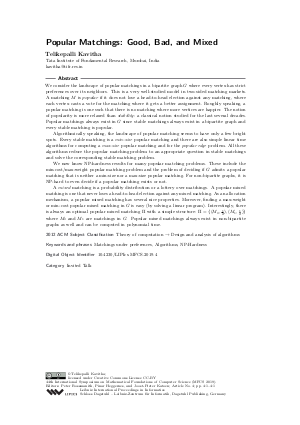Popular Matchings: Good, Bad, and Mixed (Invited Talk)
Author Telikepalli Kavitha
-
Part of:
Volume:
44th International Symposium on Mathematical Foundations of Computer Science (MFCS 2019)
Part of: Series: Leibniz International Proceedings in Informatics (LIPIcs)
Part of: Conference: Mathematical Foundations of Computer Science (MFCS) - License:
 Creative Commons Attribution 3.0 Unported license
Creative Commons Attribution 3.0 Unported license
- Publication Date: 2019-08-20
File

PDF
LIPIcs.MFCS.2019.4.pdf
- Filesize: 192 kB
- 1 pages
Document Identifiers
Subject Classification
ACM Subject Classification
- Theory of computation → Design and analysis of algorithms
Keywords
- Matchings under preferences
- Algorithms
- NP-Hardness
Metrics
- Access Statistics
-
Total Accesses (updated on a weekly basis)
0Document
0Metadata
Abstract
We consider the landscape of popular matchings in a bipartite graph G where every vertex has strict preferences over its neighbors. This is a very well-studied model in two-sided matching markets. A matching M is popular if it does not lose a head-to-head election against any matching, where each vertex casts a vote for the matching where it gets a better assignment. Roughly speaking, a popular matching is one such that there is no matching where more vertices are happier. The notion of popularity is more relaxed than stability: a classical notion studied for the last several decades. Popular matchings always exist in G since stable matchings always exist in a bipartite graph and every stable matching is popular.
Algorithmically speaking, the landscape of popular matching seems to have only a few bright spots. Every stable matching is a min-size popular matching and there are also simple linear time algorithms for computing a max-size popular matching and for the popular edge problem. All these algorithms reduce the popular matching problem to an appropriate question in stable matchings and solve the corresponding stable matching problem.
We now know NP-hardness results for many popular matching problems. These include the min-cost/max-weight popular matching problem and the problem of deciding if G admits a popular matching that is neither a min-size nor a max-size popular matching. For non-bipartite graphs, it is NP-hard to even decide if a popular matching exists or not.
A mixed matching is a probability distribution or a lottery over matchings. A popular mixed matching is one that never loses a head-to-head election against any mixed matching. As an allocation mechanism, a popular mixed matching has several nice properties. Moreover, finding a max-weight or min-cost popular mixed matching in G is easy (by solving a linear program). Interestingly, there is always an optimal popular mixed matching Pi with a simple structure: Pi = {(M_0,1/2),(M_1,1/2)} where M_0 and M_1 are matchings in G. Popular mixed matchings always exist in non-bipartite graphs as well and can be computed in polynomial time.
Cite As Get BibTex
Telikepalli Kavitha. Popular Matchings: Good, Bad, and Mixed (Invited Talk). In 44th International Symposium on Mathematical Foundations of Computer Science (MFCS 2019). Leibniz International Proceedings in Informatics (LIPIcs), Volume 138, p. 4:1, Schloss Dagstuhl – Leibniz-Zentrum für Informatik (2019)
https://doi.org/10.4230/LIPIcs.MFCS.2019.4
BibTex
@InProceedings{kavitha:LIPIcs.MFCS.2019.4,
author = {Kavitha, Telikepalli},
title = {{Popular Matchings: Good, Bad, and Mixed}},
booktitle = {44th International Symposium on Mathematical Foundations of Computer Science (MFCS 2019)},
pages = {4:1--4:1},
series = {Leibniz International Proceedings in Informatics (LIPIcs)},
ISBN = {978-3-95977-117-7},
ISSN = {1868-8969},
year = {2019},
volume = {138},
editor = {Rossmanith, Peter and Heggernes, Pinar and Katoen, Joost-Pieter},
publisher = {Schloss Dagstuhl -- Leibniz-Zentrum f{\"u}r Informatik},
address = {Dagstuhl, Germany},
URL = {https://drops.dagstuhl.de/entities/document/10.4230/LIPIcs.MFCS.2019.4},
URN = {urn:nbn:de:0030-drops-109489},
doi = {10.4230/LIPIcs.MFCS.2019.4},
annote = {Keywords: Matchings under preferences, Algorithms, NP-Hardness}
}
